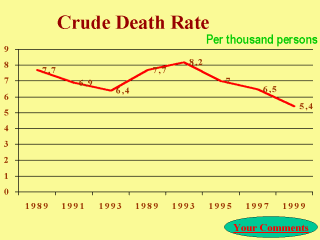In 1990, the
crude death rate was 7 per 1000 population, compared to 8.1 in 1985. During 1991-94, this
rate increased by 13 percent, particularly due to declining quality of health services In
1990, the crude death rate was 7 per 1000 population, compared to 8.1 in 1985. During
1991-94, this rate increased by 13 percent, particularly due to declining quality of
health services. The expectation of life in 1989 for the country as a whole was 65.2 years
and in 1997 this decreased to 64.7 years. The mortality rate in urban areas is higher than
in the rural areas and rural life expectancy is 0.6 years higher than that of urban areas.
Female life expectancy exceeds male life expectancy by 7.3 years in urban areas and by 3.8
years in rural areas in 1997. The infant mortality rate in 1997 was 37.1 per 1000 births,
compared to 45.2 in 1990. The main cause of infant mortality is acute respiratory
infections (ARI) and diarrhea. Maternal mortality continues to be high at about 70 per
100,000 live births and over 70 percent of women suffer from anemia and iron deficiency.
General mortality rate in 1998 was 6.35 per 1000 population. The
main causes of death were cardiovascular disease (229.6 per 100,000 population),
respiratory disease (142.3), parasitic diseases (70.6) and injuries and poisoning (48.9).
The number of cardiovascular, respiratory and endocrine system and blood diseases
continues to increase while mortality from cancer and from injury and poisoning has been
falling. Overall life expectance is low and has been stagnant since the start of the
transition.
